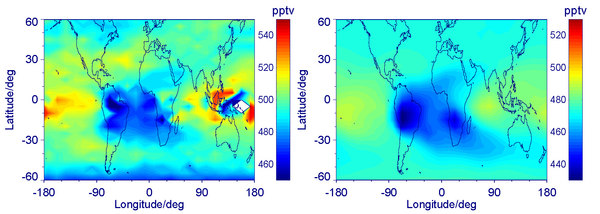MIPAS detects a tropical COS-sink

Left panel: COS distribution measured by MIPAS between December and February 2002-2012 at the 250 hPa level (~11 km). A large-scale minimum is visible, reaching from tropical South America to West- and South Africa. The minimum is caused by uptake of COS by tropical vegetation, which during this season (austral summer) is especially pronounced. Right panel: The COS sink is reproduced in very good agreement by simulations with the PCTM chemical transport model.
Carbonyl sulfide (COS) is a potential co-tracer for investigation of the carbon cycle, since its uptake by plants is assumed to be similar to the photosynthetic assimilation of CO2. However, up to now global observations of COS are sparse. We derived a comprehensive global COS data set from MIPAS measurements. Major features of this data set in the tropical upper troposphere are enhanced values above the western Pacific and Indonesia especially in boreal summer and a minimum between tropical South America, West- and South Africa, which is most pronounced in austral summer. This widespread minimum, caused by uptake of COS by tropical vegetation, was observed by MIPAS for the first time. The observations are reproduced by simulations of two different global models, when a large vegetation uptake and a corresponding increase in emissions from the tropical oceans, as proposed in several recent publications, is assumed.
For further details see: http://onlinelibrary.wiley.com/doi/10.1002/2015GL066293/full
